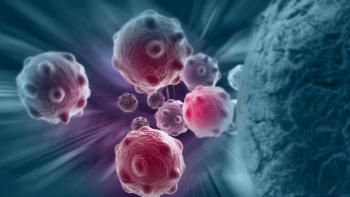
Biomarkers for the Prognostication of Graft vs Host Disease
Expert hematologist/oncologists share their perspectives on use of biomarkers to help prognosticate graft vs host disease.
Episodes in this series

Transcript:
Yi-Bin Chen, MD: You mentioned one way to prognosticate graft vs host disease [GVHD], which is based on clinical criteria, the Minnesota GVHD Risk Score. The other way that’s been discussed at length in our meetings has been with noninvasive biomarkers. The MAGIC [Mount Sinai Acute GVHD International Consortium] has done a lot of work defining and measuring these 2 serum biomarkers called REG3A and ST2, which are supposed to be surrogates for mucosal injury. Based on their MAP, or MAGIC algorithm probability, that has been shown, at least in retrospective analyses, to be able to prognosticate patients at the onset of GVHD for differential risk of nonrelapse mortality. This biomarker score is commercially available; we can all send it off. We at Massachusetts General Hospital don’t send it off because there haven’t been any trial data to show me or my colleagues that we should change our management prospectively based on this score. Do you guys send it off to help in your management? Hana, you’re nodding your head. Go ahead.
Hana F. Safah, MD: I do. As as you said, there are patients, as Amin alluded to, who come in with GI [gastrointestinal] disease stage 1 and skin, and they do poorly. I’m trying to know if the markers are high clinically. I teach my fellows that you have to follow your patients. Within 3 to 5 days, you want to make sure they’re not progressing. In 5 days, you want to make sure that they’re responding. In 7 days, they have to respond clinically. This is going to tell you how they’re going to do with the treatment and how to change the treatment accordingly. However, the biomarkers I use give me an idea of who’s going to do well, and who I’m going to keep in the hospital because the expectation is going to be that they’re not going to do well with the first-time therapy, and I’m going to keep bringing them to the clinic with more frequent follow-up appointments. I don’t use biomarkers to change treatment plans. I use biomarkers for prognostication—what’s the expectation before starting the first-line treatment and at 7 days afterward?
Amin M. Alousi, MD: If I could take the flip side of that coin, the fear is that when you do order that, once you have that information, you will make treatment decisions based on it. Of course, we don’t have any evidence that treating patients differently, based on the biomarker, is helpful. The one caveat that I think was pivotal in the field of biomarker research, and pivotal to GVHD research in general, was also out of the MAGIC consortium. This looked at biomarkers on day 7. That’s an area where the data are very interesting. If you look at the traditional definition of who responds to steroids, the patients who progress after 3 days of a high dose, or who fail to respond by 7 to 10 days, those patients are “steroid refractory.” When the MAGIC consortium looked at the biomarkers on day 7, they looked at the percentage of the population who would be characterized as being steroid refractory based on that definition. They had very interesting findings.
About 50% of the patients who met the definition of steroid-refractory returned with a biomarker that suggests that they were low risk, and about 50% returned with a high-risk phenotype. When they looked at that roughly 50% of patients who would be otherwise characterized as steroid refractory but had a low-risk biomarker, they found that their outcome¾ with respect to being in a GVHD response at day 28 and their likelihood of experiencing treatment-related mortality at 6 months¾ was exactly the same as those who were characterized as being steroid responders. That tells us that about 50% of the patients may be what I like to call “slow responders” to steroids, but not truly refractory. That may be where the biomarkers may play a role in day-to-day clinical use. I fear that once you have that information up front, improper treatment decisions would be made where we don’t have evidence to support that.
Yi-Bin Chen, MD: It’s like a lot of areas of medicine. We have more toys than we know what to do with at the moment. I agree with you. I think the biomarkers could have a huge role in helping us refine response, especially for patients with unclear clinical status, meaning stable disease or so forth, because our rudimentary assessments of body surface area skin rash, or volume of diarrhea are incredibly primitive for a disease in which we probably can’t get a glimpse into the biology.
Transcript edited for clarity.
Newsletter
Stay up to date on recent advances in the multidisciplinary approach to cancer.






















































































